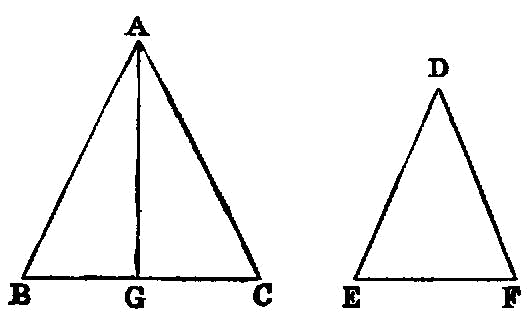Proposition 6.19

Similar triangles are to one another in the duplicate ratio of the corresponding sides.
Let ABC, DEF be similar triangles having the angle at B equal to the angle at E, and such that, as AB is to BC, so
is DE to EF, so that BC corresponds to EF; [V. Def. 11] I say that the triangle ABC has to the triangle DEF a ratio duplicate of that which BC has to EF.
For let a third proportional BG be taken to BC, EF, so that, as BC is to EF, so is EF to BG; [VI. 11]
and let AG be joined.
Since then, as AB is to BC, so is DE to EF, therefore, alternately, as AB is to DE, so is BC to EF. [V. 16]
But, as BC is to EF, so is EF to BG; therefore also, as AB is to DE, so is EF to BG. [V. 11]
Therefore in the triangles ABG, DEF the sides about the equal angles are reciprocally proportional.
But those triangles which have one angle equal to one angle, and in which the sides about the equal angles are reciprocally proportional, are equal; [VI. 15]
therefore the triangle ABG is equal to the triangle DEF.
Now since, as BC is to EF, so is EF to BG, and, if three straight lines be proportional, the first has to the third a ratio duplicate of that which it has to the second, [V. Def. 9] therefore BC has to BG a ratio duplicate of that which CB
has to EF.
But, as CB is to BG, so is the triangle ABC to the triangle ABG; [VI. 1] therefore the triangle ABC also has to the triangle ABG a ratio duplicate of that which BC has to EF.
But the triangle ABG is equal to the triangle DEF; therefore the triangle ABC also has to the triangle DEF a ratio duplicate of that which BC has to EF.
Therefore etc.
PORISM.
From this it is manifest that, if three straight
lines be proportional, then, as the first is to the third, so is the figure described on the first to that which is similar and similarly described on the second. Q. E. D.
